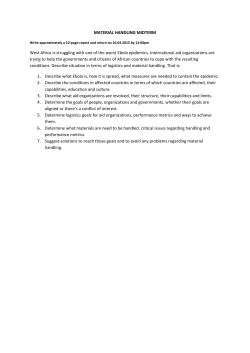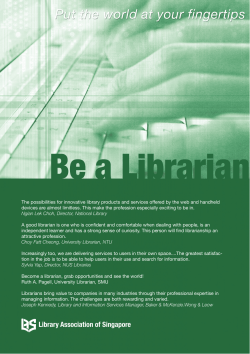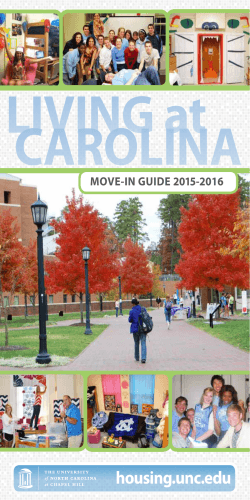
Administrative Board of the Library
Report of the Administrative Board of the Library to Faculty Council Friday, March 20, 2015 Membership of the Administrative Board of the Library Last Name First Name Dept Constituency/ Electoral Division Term Expires Balaban Bettin Brundage Copenhaver Dalton Forsyth Rita Jade Fitz Gregory Robert Brannum Social Sciences Humanities Social Sciences Natural Sciences AA Libraries Undergrad 2015 2015 2014 2017 2016 2015 Johnson Justin Economics Drama/Art History Biology Univ Lib Undergraduate Rep Graduate Rep Langbauer Laurie ENGL & CL Humanities 2014 Michalak Sarah Libr Sci EO Moran Barbara Libr Sci O Neill Hugh Business Schoultz Lars Poli Sci TollesonRinehart Vision Sue Pediatrics Todd Biology University Librarian Chr Appt. AA Prof Schools Chr Appt. AtLarge Chr Appt. AtLarge Chr Appt Health Affairs Natural Sciences Graduate Student 2015 2015 2015 2015 2017 2015 6 Meetings during the academic year Report prepared by Hugh O’Neill (chair) Overview The year’s activities built on the 2013-2018 Strategic Plan and ongoing initiatives. This section will deal will ongoing initiatives. Report of the Administrative Board of the Library to Faculty Council Friday, March 20, 2015 Membership of the Administrative Board of the Library The Board continued to voice its support of the Open Access Task force, co-chaired by ABL board member Todd Vision. The board welcomed a report form Anne Gilliland, Scholarly Communications Officer, describing the success of Open Access Week during October. The Board reviewed the results of the Ithaka Student Survey, presented by Heather Gendron, UNC’s art Librarian and Library Assessment Coordinator. The survey provided evidence that the library continues to be a starting point for research for undergraduates and graduates. More than half of the respondents reported that library staff helps them find and use information. The students recognized the library as a key source for the use of technology in their research. Student satisfaction and use of the library exceeded that reported at another research university surveyed during this period (Indiana University). The undergraduates expressed a desire for 24/7 hours at Davis library. The board discussed the budget issues for 24/7 access, which are material. Library staff will work to optimize access at peak times. The graduate students requested more digital resources. There are ongoing efforts to digitize the collections. As with last year’s Ithaka survey of the faculty, this student report helped identify areas that could be improved and triggered action plans for various library departments. The Board considered ongoing and future changes to the physical plant. University Librarian Robert Dalton reported on the physical changes in the Davis Library, wherein room was created for the Research Hub on the second floor. Periodicals and the reference collection were moved to different parts of the library. The move took place with minimum disruption and expense. Some researchers did express some concern that some reference materials are less accessible, but most users quickly adjusted to the change. Tim Hoke of Hoke/New Vision Architects and Michael Pierce from UNC’s Facilities Planning Office reported on the changes still to come to the Davis Library. These changes address life safety improvements which will bring the Davis up to current code. The changes include a new sprinkler system, improved fire alarm system and security of emergency exit doors, and improved smoke removal. The budget for these items has been approved. Actual costs are not fully determined pending the approval of designs by the state. Approval is anticipated in a reasonable period. The design will facilitate some improvements in access and service in the library. The intent for as much of the work during times of minimal use, but there will be some disruptions caused by the challenges of construction. The work will take 12 to 18 months. At different times, the Administrative Board and the Friends of the Library attended presentations on the Research Hub. Hosts included Jill Sexton, Head of Digital Research Services, Danianne Mizzy, head of the Kenan Science library, and GIS librarians Amanda Henley and Phil McDaniel. Presentations included data visualization; digital humanities research techniques, the Google Earth Liquid Galaxy, and 3-D printing. The presentations emphasized the increasing use of library based technology in analyzing and solving problems, and the cross-discipline approaches common in research. The Board hopes that the Report of the Administrative Board of the Library to Faculty Council Friday, March 20, 2015 Membership of the Administrative Board of the Library Visible excitement evidenced among of potential sponsors (Friends of the Library) triggers tangible support in the future. At a separate meeting, Peggy Myers, Director of Library Development, presented the details of the fund raising campaign. State funds provide only 80% of the operating funds of the library, and private funds will play an increasing role in both operating and capital expenditures. Projected lead gifts for the campaign include funding the Persian Collections, naming opportunities for library buildings (Health Sciences), library facilities (Special Collections in Wilson Library; Grand Reading Room in the Wilson Library), and support for named librarian positions and technology. The Board received reports addressing the issues of specific libraries. Richard Szary reported on efforts to continue efforts to digitalize the Southern History Collection, and efforts to use the collection both as a source of research opportunity for students, and a vehicle for collaboration with institutions. James Curtis of the Health Library reported on the increasing involvement of library resources in providing “real-time” data and training to facilitate response to emerging public health issues. UNC is a key node in the Ebola response network (http://guides.lib.unc.edu/ebola). The Board met in closed session to consider the matter of the Administrative Review of Sarah Michalak, Associate Provost and University Librarian. The Board supported reappointment, and has full confidence that we have the right leader as we go forward. The Strategic Plan The Strategic Plan for 2013-2018 listed three major themes: the research life cycle, transformative teaching and learning, and service to the community. There is visible evident of progress. The library has increased its presence and visibility in access and analysis of data, in the application of time, talent and space for teaching, and in the spread of service to the community. The fast forming response to the spread of concern about the Ebola crisis provides a compelling illustration of the three themes converging to create an important resource for the community. Issues Going Forward The progress to date is tribute the creativity and commitment of many talented people throughout the library and university system. Continued progress requires that same level of commitment, with focus on either attaining new resources, or reprioritizing resource allocations within the system. Given the uncertainty in all sources of funds, we likely will have to reprioritize some allocations. Conclusion The Board recognizes that we will need strong leadership skills at the library and throughout the university. Our increasing reliance on technology requires both capital and operating expenses, and our buildings require updating. The inflation rate in acquisitions costs remains higher than general inflation. Report of the Administrative Board of the Library to Faculty Council Friday, March 20, 2015 Membership of the Administrative Board of the Library In the near (and perhaps long term) state support is unlikely to grow. The university started a centralized fund as a temporary measure to fund library inflation in 1997. We have stretched the definition of temporary beyond reason, and fund is now on track to be 36% of expenditure for materials acquisitions in 2016/17. The University Administration has found the funds in past years, but we all recognize that there is a challenging fiscal environment in the future. Since 2008, the library has reduced 49 FTE staff. If funds are cut this year, the level of acquisitions for collections will have to be reduced. In recent years, low priority acquisitions (those labelled ‘”C” and “D”). Future acquisitions cuts will be more challenging. The Board notes that we need to give up some of what we have had in the past to continue to build the virtual learning library required to serve the 21st century. Respectfully Submitted, Hugh M. O’Neill O’Herron Distinguished Scholar and Professor of Strategy Chair of the Administrative Board of the Library
© Copyright 2025

















